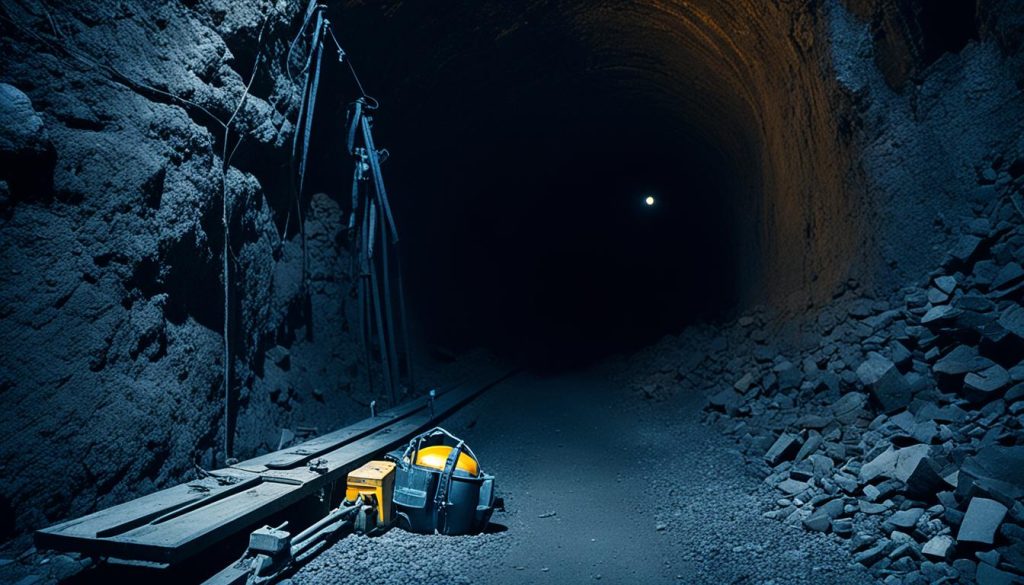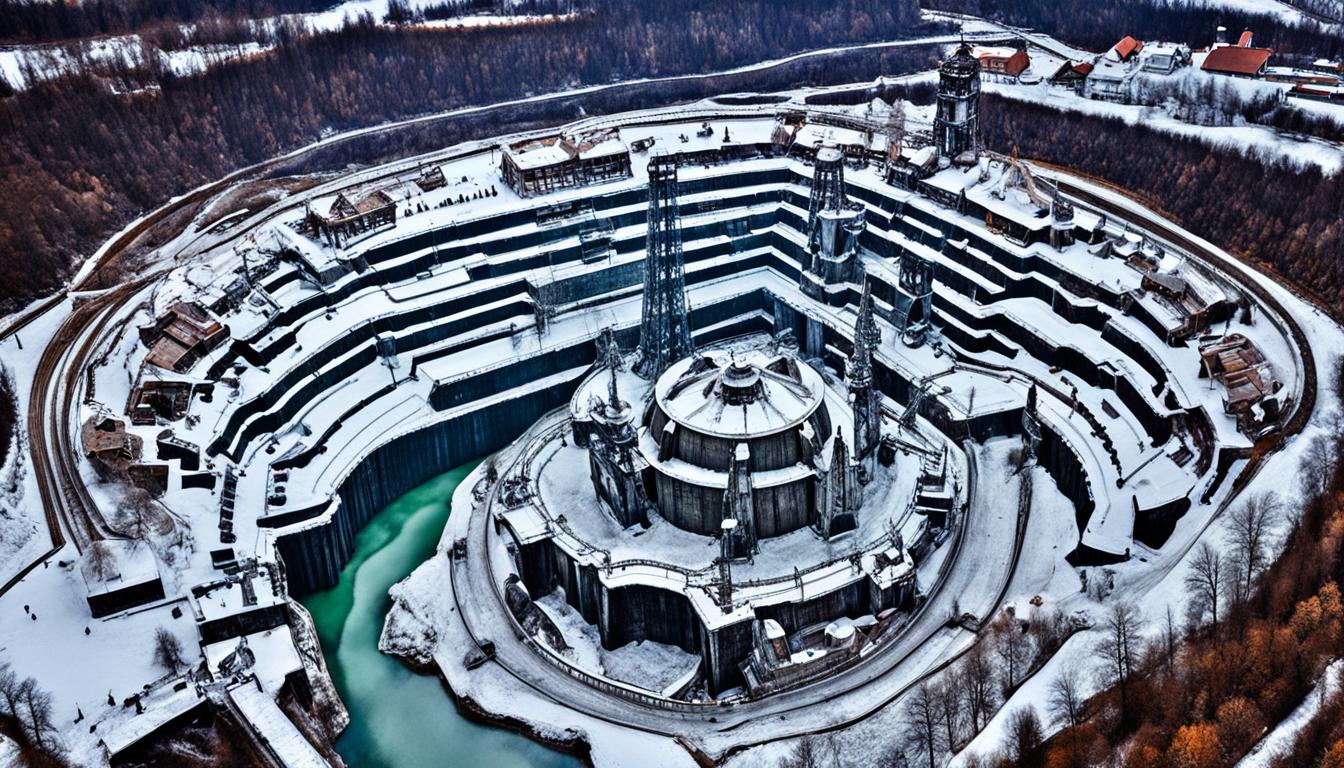Poland’s allure isn’t just in its landscapes. Below ground, it hides incredible riches. The Wieliczka Salt Mine and Bochnia Salt Mine showcase Poland’s rich history and natural beauty. These mines tell a story of geology and human skill. Visitors can see how people and nature have worked together for centuries.
Key Takeaways
- Unearth the hidden beauty of Poland’s natural wonders with a salt mines visit.
- Experience the intriguing world of subterranean tourist attractions in Poland.
- Discover the underground heritage of the Wieliczka Salt Mine and Bochnia Salt Mine.
- Explore the historical significance of some of the oldest mining sites in the world.
- Witness the blending of natural wonder with human artistry.
A Historical Journey through Poland’s Salt Mining Heritage
Exploring Polish traditions, we must not skip the salt mining history. It has been a key part of the economy and culture for thousands of years. This part of history shows how salt extraction techniques changed over time. It also shows famous cultural heritage sites recognised by UNESCO World Heritage.
The Origins of Salt Mining in Poland
Salt was very valuable in ancient times, crucial for ancient Polish industries. The need for this important mineral led to a complex network of mines. Salt extraction here dates back to the Neolithic era.
Evolution of Salt Extraction Techniques
The way people got salt in Poland changed a lot over the years. It moved from simple brine evaporation to complex mining. Now, the industry uses modern technology and machinery, showing innovation and adaptation.
Significant Salt Mines: From Wieliczka to Bochnia
The Wieliczka and Bochnia Salt Mines are central to Poland’s salt mining story. They show the cultural and technological progress over time. These sites are more than just mines; they symbolise the nation’s rich heritage.
| Site | Date Established | UNESCO Status | Modern-Day Use |
|---|---|---|---|
| Wieliczka Salt Mine | 13th Century | 1978 | Tourist Attraction & Health Resort |
| Bochnia Salt Mine | 13th Century | 2013 | Cultural Site & Recreational Facility |
Reflecting on these ancient mines reminds us of their importance. They help preserve Poland’s culture. They also matter to us now and in the future.

Discover the Wonders of Salt Mines in Poland
Dive into Poland’s salt mines to see amazing underground wonders. These ancient mazes are not just historical. They are also places of art, culture, and health.
Grand Chambers and Underground Cathedrals
The vast underground galleries are breathtaking. Rock salt artistry decorates the chambers. The salt mine chapels, glowing with chandeliers, show centuries of devotion and skill.
The Health Benefits of Salt Mine Microclimates
The mines also boost health with their unique air. Techniques like Speleotherapy and halotherapy use these minerals. They help with various conditions, enhancing wellbeing underground.
Art and Sculptures Carved from Rock Salt
Miner-artisans have turned corridors into a historic display. Sculptures from rock salt show relief work and figures. They celebrate miners’ efforts and an artistic legacy.
| Feature | Artistic Value | Health Benefit |
|---|---|---|
| Chapels and Carvings | Represents spiritual and historical narratives | Encourages reflection and peace of mind |
| Subterranean Galleries | Hosts a variety of salt sculptures and installations | Provides unique respiratory benefits |
| Speleotherapy Clinics | Utilises the charm of salt caves for healing environments | Offers treatments for asthma and allergies |
Conclusion
Exploring Poland’s beauty reveals the key role of eco-friendly travel. It helps protect and highlight the country’s gems. The salt mines tell a rich story of past wealth and now offer valuable lessons. Visiting them teaches us about old achievements and current conservation.
The care for Poland’s heritage, especially the salt mines, shows deep respect for history. It keeps the mines beautiful for everyone. They are not just historical sites but also places to learn about science and our impact on Earth.
Poland’s dedication to keeping its historical spots safe is clear. Efforts to offer educational trips that respect the environment highlight this. Visitors come for fun or knowledge and leave with a deep appreciation. They see the incredible mix of natural beauty and human creativity in the salt mines.
FAQ
What are some of Poland’s natural wonders to explore?
Poland offers many natural wonders. Among these, the Wieliczka and Bochnia Salt Mines stand out. These underground sites show off Poland’s geological and historical splendour.
Can you tell me more about the Wieliczka Salt Mine?
The Wieliczka Salt Mine is a famous underground marvel in Poland. Dating back to the 13th century, it’s a UNESCO site. This mine has beautiful tunnels, vast chambers, and rock salt chapels made by miners.
What makes Bochnia Salt Mine significant?
The Bochnia Salt Mine is among the world’s oldest salt mines. Active since the 13th century, it highlights Polish mining heritage. It’s a window into the past, showing Poland’s rich mining history.
How did salt mining techniques evolve in Poland?
Salt mining in Poland started with simple hand tools. Over time, it grew into advanced technology. This shift mirrors changes in tools, geology understanding, and era-specific needs.
Are there any health benefits associated with Poland’s salt mines?
Indeed, Poland’s salt mines are known for their health benefits. They offer therapeutic treatments like speleotherapy and halotherapy. These use salt’s natural properties to help with respiratory issues and improve wellness.
What can visitors expect to see in the salt mines’ underground galleries?
Visitors to the salt mines will see a world of miner artistry. The galleries house magnificent salt sculptures and chapels. They also feature large halls that blend natural beauty with human creativity.
Is visiting Poland’s salt mines considered sustainable tourism?
Yes, touring Poland’s salt mines supports sustainable tourism. Conservation efforts help protect these sites. Moreover, educational programs teach visitors about the mines’ history and the need to preserve cultural treasures.



